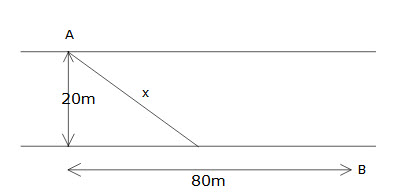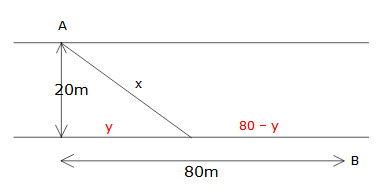Forum Replies Created
-
AuthorPosts
-
in reply to: Maxima/Minima – Application Problems #11469
 Grant is at point A on one side of a 20m wide river and needs to get to point B on the other side 80 m along the bank as shown. Grant swims to any point on the other bank and then runs along the side of the river to point B. If he can swim at 7 km/h and run at 11 km/h, find the distance he swims (x) to minimise the time taken to reach point B. Answer to the nearest metre.
Grant is at point A on one side of a 20m wide river and needs to get to point B on the other side 80 m along the bank as shown. Grant swims to any point on the other bank and then runs along the side of the river to point B. If he can swim at 7 km/h and run at 11 km/h, find the distance he swims (x) to minimise the time taken to reach point B. Answer to the nearest metre.
y2 = x2 – 202
$$y = \sqrt {{x^2} – 400} $$
let T = time taken where t1 is the time to swim (x) and t2 is the time to run (80 – y)
$${t_1} = \frac{x}{7}$$ and $${t_2} = \frac{{80 – y}}{{11}}$$
$$T = \frac{x}{7} + \frac{{80 – \sqrt {{x^2} – 400} }}{{11}}$$
$$T = \frac{x}{7} + \frac{{80 – {{\left( {{x^2} – 400} \right)}^{\frac{1}{2}}}}}{{11}}$$
$$T’ = \frac{1}{7} + \frac{{ – \frac{1}{2}{{\left( {{x^2} – 400} \right)}^{ – \frac{1}{2}}} \times 2x}}{{11}}$$
$$T’ = \frac{1}{7} – \frac{x}{{11\sqrt {{x^2} – 400} }}$$
$$T’ = \frac{1}{7} – \frac{x}{{11\sqrt {{x^2} – 400} }} = 0$$
$$\frac{x}{{11\sqrt {{x^2} – 400} }} = \frac{1}{7}$$
$$\frac{{{x^2}}}{{121({x^2} – 400)}} = \frac{1}{{49}}$$
49x2 = 121(x2 – 400)
49x2 = 121x2 – 48,400
–72x2 = – 48,400$${x^2} = \frac{{6050}}{9}$$
$$x = \pm \frac{{\sqrt {6050} }}{3}$$
x ≈ ±25.927
test x= 26 (to the nearest metre and x >0 as a measurement)
x 25 26 27
T’ –0.009 0 0.008
\ _ /
hence T minimum when x = 26min reply to: Sum & Difference Of Two Cubes #11328Factorise 81x3 + 192.
= 3(27x3 + 64)
= 3(3x + 4)(9x2 – 12x + 16)in reply to: Discriminant #11284Show that the roots of the quadratic equation x2 + (k + 2)x + k = 0 are real and different for all values of k.
Δ = b2 – 4ac
Δ = (k + 2)2 – 4 × 1 × k
Δ = k2 + 4k + 4 – 4k
Δ = k2 + 4
since k2 ≥ 0 for all k, then k2 + 4 > 0 for all k,
hence real distinct rootsin reply to: Absolute Values #10960Solve |2x – 1| ≥ 3.
2x – 1 ≥ 3 2x – 1 ≤ -3
2x ≥ 4 2x ≤ -2
x ≥ 2 x ≤ -1
∴ x ≤ -1, x ≥ 2
in reply to: Worded Problems #10492A small town is renowned for spreading rumours. All of its citizens are aware in a short time of any new rumours. The spread of the rumour can be summarised in the table below right. If the number of citizens who have been told the rumour each day continues to follow a geometric sequence, find:
a. a rule for the number of citizens in day n
b. the number of citizens told of the rumour by day 5
c. on which day all 4230 citizens will know of the rumour.Day number Number of citizens in the know
1 1
2 6
3 36a. 1, 6, 36, …
a = 1, r = 6
Tn = 1 × 6n – 1
Tn = 6n – 1b. T5 = 64
= 1296c. T6 = 65
= 7776
by the end of the 5th day 1296 will know and by the end of the 6th day 7776 people will know, so 4230 must be earlier in the 6th day
∴ day 6in reply to: Relationship between Roots and Coefficients #10400For what value of k will the equation x2 – (k + 1)x + (k – 5) = 0 have:
a. one root equal to zero?
b. one root which is the negative of the other?
c. one root which is the reciprocal of the other?
a. let ß = 0α + ß = –b/a
α + 0 = k + 1
α = k + 1
α ß = c/a
α × 0 = k – 5
0 = k – 5
∴ k = 5
b. α = – ß
α + ß = k + 1
– ß + ß = k + 1
0 = k + 1
∴ k = -1
c. ß = 1/ α
α ß = k – 5
α × 1/ α = k + 5
1 = k – 5
k = 6
in reply to: Relationship between Roots and Coefficients #10397Find the values of k for which the equation x2 + kx + k + 3 = 0 has
a. A root of 5
b. Equal roots
a. let α = 5α + ß = -k 5 + ß = -k
α ß = k + 3 5ß = k + 3
ß = -k – 5
5ß = -5k – 25
-5k – 25 = k + 3
6k = -28
k = -42/3
b. equal roots
equal roots: α = ß
2α = k α2 = k + 3
α = k/2
$$\frac{k^2}{4}= k + 3$$
k2 = 4k + 12
k2 – 4k – 12 = 0
(k – 6)(k + 2) = 0
k = 6 or -2
in reply to: Relationship between Roots and Coefficients #10396One of the roots of the equation 2x2 – 15x + C = 0 is four times the other root.
a. Show that the roots are 1.5 and 6?
b. Find the value of c.a. the roots are α and ß if one is four times the other, then let ß = 4α
α + ß = –b/a
α +4α = 15/2
5α = 15/2
∴ α = 1.5
as ß = 4α then
ß = 4 × 1.5
ß = 6
b. αß = c/a which means
α × 4α = c/2
4α2= c/2
and since α = 1.5 then 4 × 1.52 = c/2
c/2 = 9
∴ c = 18
in reply to: Simplifying Surds #10281Simplify √300.
= √100 × √3
= 10√3in reply to: Simplifying Surds #10278Simplify √50.
= √25 × √2
= 5√2in reply to: Rationalising The Denominator #10262Rationalise $$\frac{6}{7\sqrt5}$$.
=$$\frac{6}{7\sqrt5}\times\frac{\sqrt5}{\sqrt5}$$
= $$\frac{6\sqrt5}{7\times 5}$$
= $$\frac{6\sqrt5}{35}$$>
-
AuthorPosts



